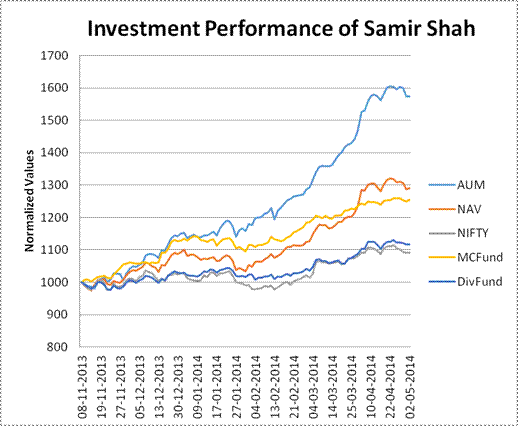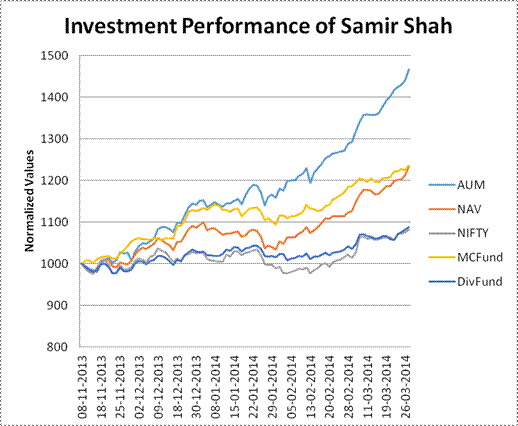How has been my investment performance? Every month, on the day after expiry, I will post my current investment performance in the form of this graph.

Just a brief explanation of the above.
I started monitoring my portfolio rigidly from November 8, 2013. On that day, I also started monitoring the performance of the Nifty, a top ranking Midcap Fund, and a top ranking diversified fund. Look towards the bottom of this post to find a summary of my performance.
What I did was the following:
a) Creating a Normalized Assets under Management
I took my total portfolio, on the starting date, and normalized it to a starting position of a 1000, by choosing an arbitrary divider. (For example, if my total portfolio was Rs. 21000, then my divider was 21). This represents my total assets under management (AUM), normalized. On every day, the total portfolio is divided by the same arbitrary divider to get the normalized AUM. (For example, if the portfolio would grow to Rs. 42000, then the normalized AUM would become (42000/21) 2000.
b) Calculating an initial NAV
I assumed an NAV of Rs. 1000 on the starting date, and divided the total portfolio value to get the number of units on the starting date. Sticking to our prior example, for a total portfolio size of Rs. 21000, the number of units would be 21.
c) Accounting for buying and selling
On each day I did some selling or buying of stocks, I calculated the net purchase or sale. This figure would be +ve for net purchases, or -ve for net sales. I then divided this by the previous day’s NAV to find out the net change in the units. For example, if on November 9, 2013, I bought a 1000 Rs. worth of stock, then the number of units would increase from 21 to 22. If I sold a net of Rs.2000 worth of stock, then the number of units would decrease by 2 to 19.
d) Finding the daily NAV
On each day, I used Moneycontrol to give me my portfolio value, after accounting for buying and selling. This portfolio value was divided by the number of units, to arrive at that day’s NAV. For example, if on November 9, 2013, I had purchased a 1000 Rs. worth of stock, which would have increased the number of units to 22, and the total portfolio value at EoD of November 9, 2013 was 23000, then my NAV would be Rs. 23000/22, or Rs. 1045.
e) Accounting for Dividends
Actually, when I note that I used Moneycontrol to arrive at my total portfolio value, this is not entirely true. My total portfolio value on any day has been accounted for by adding the total portfolio value of my stocks and the total amount of dividends received by me after November 8, 2013. This means that dividends flow directly to increase the NAV, and not the number of units.
This makes sense to me. Presumably, everytime a dividend is received, the price of the stock goes down by that extent, meaning that the portfolio value of stocks is decreased to that extent. This would result in a false reduction of the NAV, which gets accounted for by the way I have handled dividends above.
6) Normalizing the values for the Nifty, and two funds- SBI Midcap Fund, and Kotak Classic Fund.
On November 8, 2013, I normalized the value of the NIFTY to 1000, and also the NAV of the two funds to a starting point of 1000.
Why did I normalize? So that it is easier to visualize these values in a graph like the one above. If each of the starting values are a 1000, then it is easy to compare performances. And I don’t end up revealing the total assets under my management. I think that my performance should be measured without reference to the actual amount of money made/lost. A young person without lots of savings might find my portfolio impressive, merely because of its size. Others may find it insignificant. Does not really matter, as what matters is the percentage return.
Summary of Performance from November to February
From November 8, 2013, to Feb 26, 2014 (approximately 3.5 months), my NAV increased from Rs. 1000 to Rs. 1114, a percentage increase of 11.4%, or an annualized increase of 39%. The Nifty in the meantime rose by 1.6%, while the Midcap Nifty and Small Cap Nifty (not presented in the graph above), rose by 1.4% and 7% respectively.
Seems impressive. Not so fast. Had I instead invested all my money in the SBI Magnum Midcap Fund, I would have returned 17% during the same period. Great performance by this fund. The Kotak Classic fund, which is more invested in front line stocks, did much worse, increasing by only 3.3% during this time.
I am still learning. I hope in a few months, that I can start beating all the funds. In the future, every month, along with the graph above, I shall also give a table of rolling returns.



